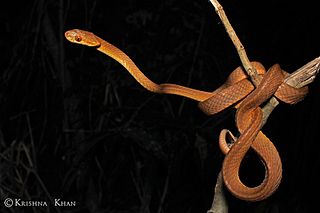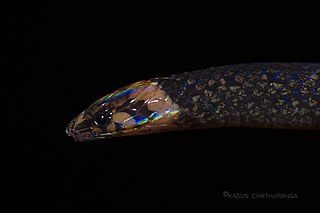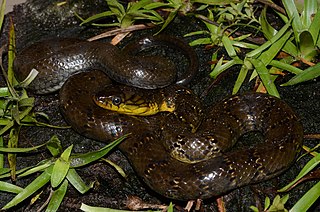
The Calabar python is a species of non-venomous snake in the family Boidae. The species is endemic to West and Central Africa. It is the only species in its genus.

Boiga ochracea, commonly called the tawny cat snake, is a species of rear-fanged snake in the family Colubridae. The species is endemic to South Asia.

The Indian egg-eating snake or Indian egg-eater is a rare species of egg-eating snake in the family Colubridae. The species is endemic to the Indian subcontinent. It is also called Westermann's snake, reflecting its scientific name. The snake belongs to the monotypic genus Elachistodon.

The Central African rock python is a species of large constrictor snake in the family Pythonidae. The species is native to sub-Saharan Africa. It is one of 10 living species in the genus Python.

Goldie's tree cobra, also known commonly as the African tree cobra and as Gold's tree cobra, is a species of venomous tree cobra in the family Elapidae. The species is native to Central and Western Africa. This species is one of the two tree cobras in Africa, the other being the black tree cobra. Goldie's tree cobra is one of the most venomous snakes and creatures in Africa.

The forest cobra, also commonly called the black cobra and the black and white-lipped cobra, is a species of highly venomous snake in the family Elapidae. The species is native to Africa, mostly the central and western parts of the continent. It is the largest true cobra species with a record length of 3.2 metres.
Cross's beaked snake is a species of snake in the family Typhlopidae. The species is native to West Africa.

Jameson's mamba is a species of highly venomous snake native to equatorial Africa. A member of the mamba genus, Dendroaspis, it is slender with dull green upper parts and cream underparts and generally ranges from 1.5 to 2.2 m in length. Described by Scottish naturalist Thomas Traill in 1843, it has two recognised subspecies: the nominate subspecies from central and west sub-Saharan Africa and the eastern black-tailed subspecies from eastern sub-Saharan Africa, mainly western Kenya.

Aspidura guentheri, commonly known as Günther's rough-sided snake, is a species of snake in the family Colubridae. The species is endemic to Sri Lanka. It is the smallest member of the genus Aspidura.

Colubroidea is a superfamily of snakes in the clade Colubroides that includes Colubridae, with some studies splitting Colubridae into multiple families that make up Colubroidea. Historically, Colubroidea also included other caenophidian snakes such as cobras and vipers, as these snakes form a clade. However these groups are now divided into several distinct, but related, families. Zaher et al. (2009) proposed to redefine Colubroidea for colubrids and related families, while designating Colubroides as the group containing vipers and cobras as well as colubroids. The ReptileDatabase considers Colubroidea to be composed of Colubridae and the members of its sister group, Elapoidea, and does not recognize the division of Colubridae into multiple families.

Tropidodipsas is a genus of New World snakes of the family Colubridae.

The large-eyed green tree snake, also known commonly as the splendid dagger-tooth tree snake, is a species of venomous snake in the family Colubridae. The species is endemic to Africa. There are three recognized subspecies.

Toxicodryas blandingii, commonly known as Blanding's cat snake and Blanding's tree snake, is a species of rear-fanged venomous snake of the family Colubridae. The species is endemic to Sub-Saharan Africa.
Stegonotus is a genus of snakes in the family Colubridae. Species of the genus Stegonotus are native to Australia, Indonesia, and New Guinea.

Boaedon olivaceus is a species of snake in the family Lamprophiidae. The species is endemic to Africa.
Limnophis is a genus of snakes in the subfamily Natricinae of the family Colubridae. The genus contains three species.
Grayia caesar, Caesar's African water snake, is a species of snake in the family, Colubridae. It is found in Equatorial Guinea, Cameroon, the Democratic Republic of the Congo, the Republic of the Congo, Gabon, Central African Republic, and Angola.

Grayia ornata, the ornate African water snake, is a species of snake in the family, Colubridae. It is found in Equatorial Guinea, Cameroon, the Democratic Republic of the Congo, the Republic of the Congo, Gabon, Central African Republic, Zambia, South Sudan, and Angola.

Grayia smithii, Smith's African water snake, is a species of snake in the family, Colubridae. It is found in Equatorial Guinea, Cameroon, the Democratic Republic of the Congo, the Republic of the Congo, Gabon, Central African Republic, Zambia, South Sudan, Uganda, Kenya, Tanzania, Rwanda, Burundi, Nigeria, Benin, Togo, Ghana, Ivory Coast, Liberia, Guinea, Guinea-Bissau, Senegal, Burkina Faso, Sierra Leone, Gambia, Niger, Chad, and Angola.
Grayia tholloni, Tholloni's African water snake, is a species of snake in the family, Colubridae. It is found in Equatorial Guinea, the Democratic Republic of the Congo, the Republic of the Congo, Central African Republic, Zambia, Ethiopia, Sudan, South Sudan, Uganda, Kenya, Tanzania, Nigeria, Senegal, Gambia, Chad, and Angola.















